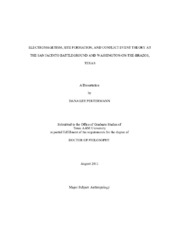| dc.description.abstract | Conflict Event theory has the potential to change how archaeologists investigate battlefield sites. As a theoretical paradigm, eventful archaeology allows us to give agency to social-structure changing events, going beyond collect artifacts after the battle is over. Coupled with site formation processes, this model allows us to project battle elements to re-create the historical events that occurred at conflict sites. Within this theoretical framework, we can begin to understand why the conflict unfolded in a particular manner. Two site of the Texian Revolution are particularly appropriate to this new theoretical model: the San Jacinto Battleground (SJB), the location of the last battle of the Texian Revolution, and Washington-on-the-Brazos (WOB), the location of the signing of the Texas Declaration of Independence.
Merging this theoretical model with an investigation of site formation processes (understanding the matrix in which the artifacts lie) and pulse-domain electromagnetic surveying allows for a much more robust approach to Battlefield Archaeology. Pulse-induction allows for the detection of discrete artifacts in the soil, and is a much more reliable method than the more commonly used magnetometry. Analyzing characteristics of the soil surrounding the artifacts then gives us a third line of inquiry as to why artifacts are in certain locations in the archaeological record, allowing for an explanation as to their quality and quantity.
La teoría del Acontecimiento del conflicto tiene el potencial para cambiar cómo arqueólogos investigan sitios de campo de batalla. Como un paradigma teórico, la arqueología llena de acontecimientos nos permite dar agencia a la social-estructura que cambia acontecimientos, yendo más allá de reúne artefactos después de que la batalla esté sobre. Asociado con procesos de formación de sitio, este modelo nos permite proyectar batalla elementos para recrear los acontecimientos históricos que ocurrieron en sitios de conflicto. Dentro de esta armazón teórica, nosotros podemos comenzar a comprender por qué el conflicto desplegó en una manera particular. Dos sitio de la Revolución de Texian es especialmente apropiado a este nuevo modelo teórico: el San Campo de batalla de Jacinto (SJB), la ubicación de la última batalla de la Revolución de Texian, y de Washington en el Brazos (WOB), la ubicación del firmar de la Declaración de Tejas de Independencia. Unir este modelo teórico con una investigación de sitúa procesos de formación (comprendiendo la matriz en la que los artefactos están) y el pulso-dominio inspeccionar electromagnético tiene en cuenta un enfoque mucho más robusto a la Arqueología del Campo de batalla. La pulso-inducción tiene en cuenta el descubrimiento de artefactos distintos en la tierra, y es un método mucho más seguro que el magnetometry más comúnmente utilizado. Analizar características de la tierra que rodea los artefactos entonces nos dan una tercera línea de indagación en cuanto a por qué artefactos están en ciertas ubicaciones en el registro arqueológico, teniendo en cuenta una explicación en cuanto a su calidad y la cantidad. | en |


